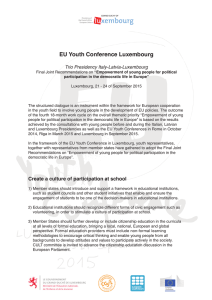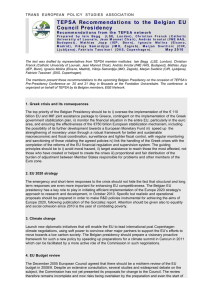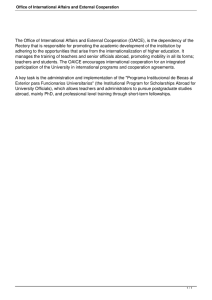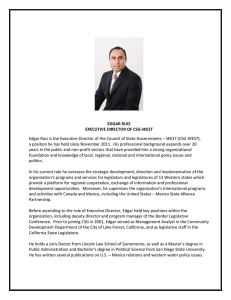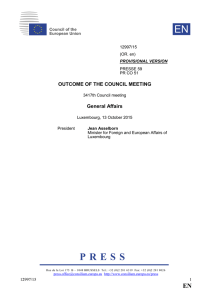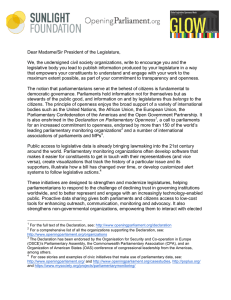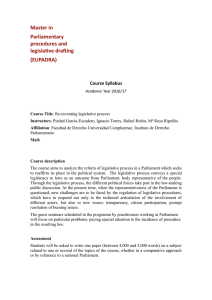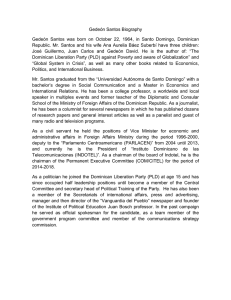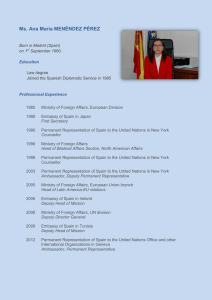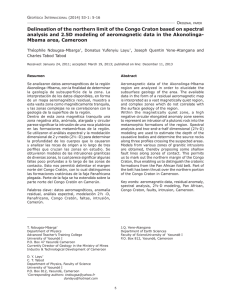CIG 35/03 jy/PGV/ag 1 CONFERENCIA DE LOS
Anuncio
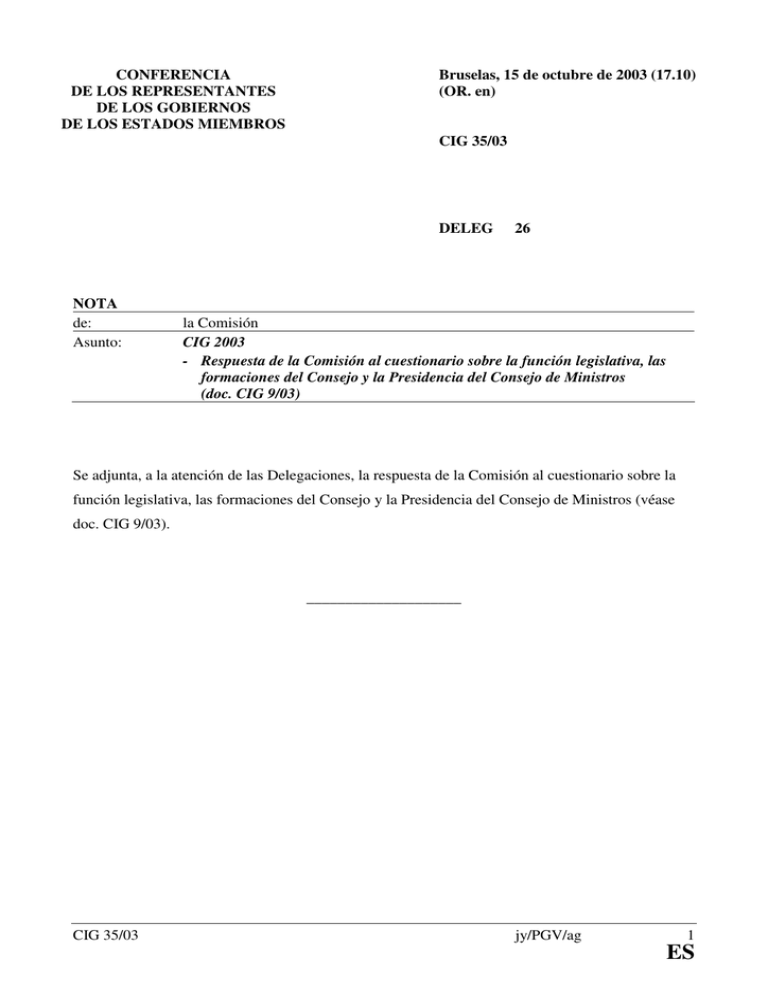
CONFERENCIA DE LOS REPRESENTANTES DE LOS GOBIERNOS DE LOS ESTADOS MIEMBROS Bruselas, 15 de octubre de 2003 (17.10) (OR. en) CIG 35/03 DELEG NOTA de: Asunto: 26 la Comisión CIG 2003 - Respuesta de la Comisión al cuestionario sobre la función legislativa, las formaciones del Consejo y la Presidencia del Consejo de Ministros (doc. CIG 9/03) Se adjunta, a la atención de las Delegaciones, la respuesta de la Comisión al cuestionario sobre la función legislativa, las formaciones del Consejo y la Presidencia del Consejo de Ministros (véase doc. CIG 9/03). ____________________ CIG 35/03 jy/PGV/ag 1 ES ANNEX I THE LEGISLATIVE FUNCTION 1. Should exercise of the legislative function be conferred on a single Council formation or should a legislative function (public) and a part dedicated to other activities be determined for each Council formation? A combined Legislative and General Affairs Council would place too many tasks on the shoulders of one body. The General Affairs Council is central to the coherence of Union action, and this must be its priority. It should not be burdened with legislative tasks. A dedicated Legislative Council could bring some benefits in terms of legislative coherence. But many Member States clearly have strong misgivings. Each Council formation should therefore be responsible for both legislative and non-legislative work within its area of responsibility. The draft Constitution has usefully clarified the Union’s legislative procedure and its instruments. The work of the Council formations could therefore be clearly structured to ensure that the legislative/public work of the Council is clearly separated from other agenda items. 2. Should the public legislative part be concerned only with laws and framework laws adopted under the normal legislative procedure (i.e. joint adoption by the European Parliament and the Council) or with all laws and framework laws? Article 45 of the draft Constitution is clear: the Council of Ministers meets in public when examining and adopting a legislative proposal. No distinction is made between acts adopted under the normal legislative procedure and other cases. There is no reason to depart from this rule. All Council discussions on legislation should be public. Indeed, discussing some legislative acts in closed session would create some very artificial distinctions. For example, it would be very difficult to explain why environmental taxes were discussed in secret whilst other environmental issues were in the open, or why open discussion on judicial cooperation in civil matters suddenly moved behind closed doors to discuss family law. 1 1 The only reason being that the Council acts alone under article III-130(2) and article III170(3), whereas articles III-130 (1) and III-170 (2) provide for the ordinary legislative procedure. CIG 35/03 ANEXO jy/PGV/ag 2 ES II THE FORMATIONS OF THE COUNCIL 3. Should the European Council’s decision on the list of Council formations – as envisaged by the Convention - be taken unanimously as stipulated in the draft Convention? by a qualified majority? or by a simple majority? Should the list be confined to a small number of formations in line with the decision taken in Seville? The current practice is for Council formations to be fixed by the Council’s rules of procedure – that is, by simple majority. This practice is consistent with the principle that on matters of procedure, Ministers sit around the table on an equal footing, but taking into account the delicate nature of the decision concerned, the Commission is open to other solutions. However, it is unclear why this decision should be given to the European Council, which is, according to the Constitution, another institution. It would be more appropriate to leave this decision to the General Affairs Council, as part of its coordinating role. This would be more consistent with the general principle according to which each institution is responsible for its internal organisation. [The decision taken at Seville remains a sensible rationalisation of the number of Council formations and this is the natural starting point for any future decision concerning the number of Council formation.] III THE PRESIDENCY OF THE COUNCIL OF MINISTERS 4. Should other Council formations apart from the Foreign Affairs Council have a fixed Presidency (i.e. not applying the rotation system provided for in Article 23(4))? which formations? of what duration? using what procedure (election by the members of the Council formations concerned)? Apart from the Foreign Affairs Council, no Council formation should have a Presidency chosen ex officio. All other formations should have a President chosen by election by the members of the Council formations concerned. This is the best guarantee of quality and effectiveness. Their mandate should last no longer than one year: any longer, and elections or Ministerial reshuffles could undermine the goal of coherence and consistency. A one-year mandate for the Presidency of each Council formation would strike a good balance between the need to ensure that serving Ministers are not overloaded, and the need to ensure continuity. A system of election would allow Council formations to benefit from the experience of their longest-serving and most respected members, and provide valuable experience for national administrations. Doubtless Ministers would wish to ensure that over time, a balance was assured between Member States. CIG 35/03 ANEXO jy/PGV/ag 3 ES Election by the others members of the Council means there is no need for team presidencies. The administrative support for each formation would be provided as now by the Council Secretariat, as well as by national administrations if the President so decides. As laid out in article 23(1) of the draft Constitution, the General Affairs Council would be responsible for ensuring consistency and moving Council business ahead in line with the Union’s inter-institutional planning. 5. Should there be a Team Presidency system for the Council formations that continue to use the rotation system? Team Presidencies are not the best approach (see response to Q4). 6. If it is decided to opt for a Team Presidency system a)how many Member States should there be in the « team »? three? four? five? b)what should be the duration of its term? a year? 18 months? longer? c) should the composition of the teams be fixed in advance or left open on the basis of criteria to be determined, with due regard for the principle of equal rotation (which would take into account political and geographical balance and the diversity of Member States as defined in Article 23 (4) of the draft Convention)? d)should the allocation of the different Council formations within the team be fixed in advance or left to the decision of the Member States in the team? See response to Q4. These questions are not relevant to a system where Presidencies are elected, and illustrate the risk that Team Presidencies will add to the Union’s complexity. 7. Given the need for increased co-ordination under a Team Presidency system, should a “chain of command” be maintained, at least partially, with the Member State chairing the General Affairs Council also chairing Coreper (I and II). Coordination will always be required, whether the Presidency is organised by a “Team” or in another way. Whichever system is adopted, it seems sensible for the choice of Minister for the Council formation to determine the administration of Council business at every level. In the case of Coreper, this would indeed mean that Coreper would be chaired by the Member State of which the GAC President is a national. 8. Should committees/working parties subordinate to a particular Council automatically be chaired by the Member State holding the Presidency of the Council in question (vertical structure)? Applying this formula to all Council committees and working parties could risk undermining the coordination role of Coreper and the GAC. Sometimes, coherence might be best served if there was no link between the Member State holding the Presidency of a Council and the chairs of the committees/working parties. There is no need to apply a single model to all Council groups. These are very different in nature and have very different tasks (e.g. examining proposals for EU legislation, coordinating national policies, coordinating the action of national authorities, giving opinions to the Council). The most appropriate solution may vary - in some cases, for example, it might be sensible to extend the current practice of committees/working parties chaired by the Council Secretariat. But in any event, there is no need to decide the best approach for each case during the IGC. CIG 35/03 ANEXO jy/PGV/ag 4 ES 9. By the same token, if the Foreign Affairs Minister chaired the Foreign Affairs Council, should the PSC and other external relations working parties be chaired by a representative of the Foreign Affairs Minister? It seems indeed appropriate for the staff of the President of this Council formation (the Foreign Minister) to chair the PSC and some other external working parties, whilst respecting strictly the special nature (“double hat”) of the function of Foreign Minister and of the special status of his services. 10. In order to achieve greater coherence in the Council’s proceedings, should there be an informal structure of co-ordination between the representatives of the Member States holding the Presidency, in which the President of the European Council, the President of the Commission and the Ministers of Foreign Affairs could participate? No, there is no need for such an “informal structure”. The draft Constitution correctly gives the task of consistency to the General Affairs Council. This is not an accident: the GAC is best placed to perform this task, because representatives of all Member States and the Commission are present. Both under a system of elected chairs and in a system of rotating Presidencies, the GAC would also be much better placed to coordinate over time than an “informal structure” most of whose members changed each time the Presidents rotated: the composition of the GAC is much more stable. In any event, the powers and role of an “informal structure” set apart from the GAC are very unclear, and raise new questions about transparency. Doubtless the Presidents of the different Council formations would be in frequent contact, if only for timetabling and other logistical questions. But there is no need to involve other institutions like the European Council and the Commission in such organisational discussions; and if the discussions were to stray into questions of policy coherence, such matters must involve all Member States. 11. Should the detailed arrangements for the rotation of the Presidency of the Council be the subject of a decision to be taken unanimously* by the European Council? If so: - should it be adopted at the same time as the Treaty establishing the Constitution? - could it be adopted later if the essential elements of the future arrangements were agreed at the same time as the Treaty establishing the Constitution? The broad principles of the system – such as election inside each Council formation and the period of office – should be agreed in the IGC. But the detail – such as the exact procedures for election – could be left until later. If this approach were taken, retaining unanimity would be less relevant.. CIG 35/03 ANEXO jy/PGV/ag 5 ES
